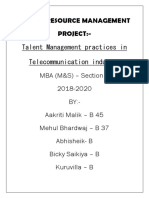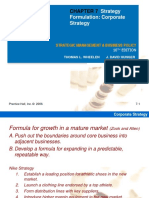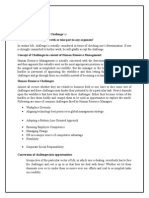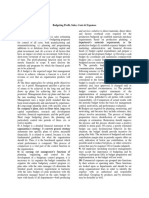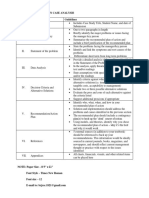HR Demand Forecasting
Uploaded by
SarathBabuCopyright:
Available Formats
HR Demand Forecasting
Uploaded by
SarathBabuOriginal Description:
Copyright
Available Formats
Share this document
Did you find this document useful?
Is this content inappropriate?
Copyright:
Available Formats
HR Demand Forecasting
Uploaded by
SarathBabuCopyright:
Available Formats
1
2
Forecasting as a Part of Human Resource
Forecasting as a Part of Human Resource
Planning
Planning
DEMAND
FORECASTING
SUPPLY
FORECASTING
Determine
organizational
objectives
Demand
forecast for
each objective
Aggregate
demand
forecast
Does
aggregate
supply meet
aggregate
demand?
Go to feasibility analysis steps
Choose human
resource programs
External programs
ecruiting
External selection
Executive
exchange
!nternal programs
"romotion
#ransfer
Career planning
#raining
#urnover control
!nternal supply forecast External supply forecast
Aggregate supply
forecast
$o
%es
3
&ong ange
'bjectives
( "lans
'verall
e)uirements
for human
resources
*or+ force
e)uirements by
occupational categories
job s+ills etc
,hort terms goals-
plans- programes
( budgets
!nventory of
"resent .uman
esources
!nventory by
'ccupational
categories
s+ills-
Demographic
characteristics
"rocedure for
Evaluating
Effectiveness or
.uman
esources
$et $e/
.uman esource
e)uirement
&eading to
action planning0
1or ecruitment
( ,election
$eeded
$eeded
eplacement
or additions0
&eading to plans
for developing-
transferring-
recruiting (
selecting
needed people
MAN POWER DEMAND FORECASTING
4
Causes of Demand for Human
Causes of Demand for Human
Resources
Resources
Economic Economic
developments developments
,ocial2 ,ocial2
political2legal political2legal
challenges challenges
#echnological #echnological
challenges challenges
Competitors Competitors
,trategic plan ,trategic plan
3udgets 3udgets
,ales ( ,ales (
production production
forecasts forecasts
$e/ ventures $e/ ventures
'rganizational 'rganizational
( job design ( job design
etirements etirements
esignations esignations
#erminations #erminations
Deaths Deaths
&eaves of &eaves of
absence absence
E!erna" E!erna"
Or#an$%a!$ona" Or#an$%a!$ona"
Wor&force Wor&force
5
HRP and En'$ronmen!a" Scann$n#
HRP and En'$ronmen!a" Scann$n#
Environmental ,canning Environmental ,canning
4
#he systematic monitoring of the major external forces #he systematic monitoring of the major external forces
influencing the organization0 influencing the organization0
Economic factors5 general and regional conditions Economic factors5 general and regional conditions
Competitive trends5 ne/ processes- services- and Competitive trends5 ne/ processes- services- and
innovations innovations
#echnological changes5 robotics and office automation #echnological changes5 robotics and office automation
"olitical and legislative issues5 la/s and administrative "olitical and legislative issues5 la/s and administrative
rulings rulings
,ocial concerns5 child care and educational priorities ,ocial concerns5 child care and educational priorities
Demographic trends5 age- composition-and literacy Demographic trends5 age- composition-and literacy
6
Scann$n# !(e In!erna" En'$ronmen!
Scann$n# !(e In!erna" En'$ronmen!
Cultural Audits Cultural Audits
4
Audits of the culture and )uality of /or+ life in an Audits of the culture and )uality of /or+ life in an
organization0 organization0
.o/ do employees spend their time? .o/ do employees spend their time?
.o/ do they interact /ith each other? .o/ do they interact /ith each other?
Are employees empo/ered? Are employees empo/ered?
*hat is the predominant leadership style of managers? *hat is the predominant leadership style of managers?
.o/ do employees advance /ithin the organization? .o/ do employees advance /ithin the organization?
3enchmar+ing 3enchmar+ing
4
#he process of comparing the organization6s processes #he process of comparing the organization6s processes
and practices /ith those of other companies0 and practices /ith those of other companies0
7
Forecas!$n# HR Re)u$remen!s
Forecas!$n# HR Re)u$remen!s
Estimate of numbers and +inds of employees the organization Estimate of numbers and +inds of employees the organization
/ill need to implement organizational strategies and attain /ill need to implement organizational strategies and attain
organizational objectives on future dates0 organizational objectives on future dates0
Demand for firm6s goods or services must be forecast0 Demand for firm6s goods or services must be forecast0
!nvolves consideration of alternative /ays of organizing !nvolves consideration of alternative /ays of organizing jobs jobs
7job design- organizational design or staffing jobs8 7job design- organizational design or staffing jobs8
Example 2 "ea+ production could be handled by temporary Example 2 "ea+ production could be handled by temporary
/or+ers or assigning overtime0 9achine brea+do/ns assigned /or+ers or assigning overtime0 9achine brea+do/ns assigned
to maintenance department or handled by machine operators to maintenance department or handled by machine operators
1orecast is then converted into people re)uirements 1orecast is then converted into people re)uirements
8
DEMAD
F!RE"A#$%&
Assum'tions of
Political
en(ironment
Assum'tions of
#ocial en(ironment
)usiness Plans
Assum'tions of
$ec*nolog+
"on,itions
Assum'tions of
-a.or mar/et
Assum'tions of
Economic $ren,s
Assumptions at the Time of demand Forecasting
Soc$a" Fac!ors * !t is common experience that a number
of /ell2conceived projects either do not ta+eoff or get
delayed due to social pressures0 !n such an event- the
human resource demand forecasts made by the planners
/ill undergo substantial changes0 Delays result in cost
escalation- changes in technology to accommodate the
needs:sentiments of society- changes in the location of
the project etc0
Tec(no"o#$ca" Fac!ors *apid changes in technology
many a times adversely affect human resources forecasts0
1rom the time a project is conceived to the time is
implemented- substantial time lag may occur during
/hich- changes in technology may ma+e the entire
project unviable0
0
Po"$!$ca" Fac!ors *;nforeseen political factors
might ma+e considerable impact on the business
plans of enterprises0 #his is true especially for
those organizations /hich depend mostly only on
international mar+ets either for the sourcing of
their ra/ materials or for selling of their products
and services0
Econom$c Fac!ors *Economic factors often
result in several planned activities being forced to
undergo considerable change0
11
Demand Generation - The reasons for the creation of
employee demands are:
Gro+!( * Gro/th- in traditional business- may lead to demand for
higher levels of production- sales volumes and services0
Em,"o-ee Turno'er* Employee turnover or attrition is another
reason for generation of manpo/er demands in an organization0
Tec(no"o#$ca" S($f!s*Changes in technology ma+es an impact on an
enterprise in more than one fashion0 #his may change the methods of
manufacturing- processes and techni)ues- selling strategies could
also become different and in the office- automation could bring about
a major change in the nature of /or+0 ,uch changes may result in a
redundant and surplus /or+force and might also bring about
shortages in the ne/ s+ills re)uired to manage the technology0
11
!0 )uantify the jobs necessary for producing a given
number of goods- or offering a given amount of
services<
!!0 determine /hat staff2mix is desirable in the future<
!!!0 assess appropriate staffing levels in different parts
of the organization so as to avoid unnecessary costs<
!=0 prevent shortages of people /here and /hen they
are needed most< and
=0 monitor compliance /ith legal re)uirements /ith
regard to reservation of jobs0
12
1orecasts employment re)uirements on the basis of some
organizational index and is one of the most commonly used
approaches for projecting . demand0
!t involves the follo/ing steps5
>0 ,elect an appropriate business factor0 #his should be the best available
predictor of human resources needs0 1re)uently- sales or value added
7selling price minus costs of materials and supplies8 is used as a
predictor in trend analysis0
?0 "lot a historical trend of the business factor in relation to number of
employees0 #he ratio of employees to the business factor /ill provide a
labor productivity ratio 7for example- sales per employee80
@0 Compare the productivity ratio for at least the past five years0
A0 Calculate human resources demand by dividing the business factor by
the productivity ratio0
./ F$na""-- project human resources demand out to the target year0
13
14
3udget and "lanning Analysis 3udget and "lanning Analysis
4
'rganizations that need human resource planning 'rganizations that need human resource planning
generally have detailed budgets and long2range plans generally have detailed budgets and long2range plans
$e/2=enture analysis $e/2=enture analysis
4
$e/ venture analysis /ill be useful /hen ne/ $e/ venture analysis /ill be useful /hen ne/
ventures contemplate employment planning0 #his ventures contemplate employment planning0 #his
techni)ue re)uires planners to estimate . needs in techni)ue re)uires planners to estimate . needs in
line /ith companies that perform similar operations0 line /ith companies that perform similar operations0
Computer2based ,imulation 9odels Computer2based ,imulation 9odels
4
9ore sophisticated forecasting approaches involving 9ore sophisticated forecasting approaches involving
computer and computer models computer and computer models
Employment data over a period of time are used
under this method as a basis for manpo/er forecast0
*hen /e record employment levels over a time
period- /e observe the B elements in it5
>0 #rend
?0 Cyclical Effects
@0 ,easonality
A0 ,tep
B0 andom fluctuations
15
Average of the combined employment level data for
the recent past is considered as the forecasted
employment level for the next period0
#his techni)ue is useful to guard against random
fluctuations0
After each period elapses - the figure for the oldest
period is dropped and the figure for the ne/est
period is added for our subse)uent computation of
manpo/er re)uirements 0
16
17
0ero*1ased forecas!$n# 4 uses current level as starting
point for determining future staffing needs
2o!!om*u, a,,roac( 4 each level of organization- starting
/ith lo/est- forecasts its re)uirements to provide aggregate
of employment needs
Ma!(ema!$ca" mode"s 4Assist in forecasting0 elationship
bet/een sales demand and number of employees needed is
positive one0
S$mu"a!$on 4 techni)ue /ith experimenting /ith real2/orld
situation through a mathematical model
F"o+ Mode"s * 1lo/ models are very fre)uently associated /ith
forecasting personnel needs0 #he simplest one is called the 9ar+ov
model0 !n this techni)ue- the forecasters /ill 5
>0 Determine the time that should be covered0 ,horter lengths of time
are generally accurate than longer ones0 .o/ever- the time horizon
depends on the length of the . plan /hich- in turn- is determined by
the strategic plan of the organization0
?0 Establish categories- also called states- to /hich employees can be
assigned0 #hese categories must not overlap and must ta+e into
account every possible category to /hich an individual can be
assigned0 #he number of states can neither be too large nor too small0
@0 Count annual movements 7also called Cflo/s68 among states for
several time periods0 #hese states are defined as absorbing 7gains or
losses to the company8 or non2absorbing 7change in position levels or
employment status80 &osses include death or disability- absences-
resignations and retirements0 Gains include hiring- rehiring- transfer
and movement by position level0
A0 Estimate the probability of transitions from one state to another based
on past trends0 Demands a function of replacing those /ho ma+e a
transition0
18
Analysis of present and future /or+load
depends on the possibility of )uantifying the
/or+ content in every area of an organizational0
,teps in /or+load analysis5
Classification of /or+
1orecasting the number of jobs
Converting the projected jobs in man2hours
Converting the man2hours into manpo/er
re)uirement
10
21
2or/3stu,+ $ec*ni4ue
2or/3stu,+ $ec*ni4ue
2or+2study techni)ues can be used /hen it is possible to apply
/or+ measurement to calculate the length of operations and
the amount of labor re)uired0
#he starting point in a manufacturing company is the
production budget- prepared in terms of volumes of salable
products for the company as a /hole- or volumes of output for
individual departments0
#he budgets of productive hours per unit of output are then
multiplied by the planned volume of units to be produced to
give the total number of planned hours for the period0
#his is then divided by the number of actual /or+ing hours for
an individual operator to sho/ the number of operators
re)uired0
Allowance will have to be made for
absenteeism and idle time.
Work-study techniques for direct
workers can be combined with ratio-
trend analysis to forecast for indirect
workers, establishing the ratio between
the two categories.
The same logic can be extended to any
other category of employees.
21
22
Forecasting Deman,
Forecasting Deman,
Quantitative Methods Quantitative Methods
Quantitative Methods Quantitative Methods
Qualitative Methods Qualitative Methods
Qualitative Methods Qualitative Methods
Forecasting Demand
Forecasting Demand
Forecasting Demand
Forecasting Demand
23
Duantitative 9ethods of 1orecasting .
Duantitative 9ethods of 1orecasting .
Demand
Demand
Moving
average
Exponential
smoothing
Trends
projections
5 Averages data about HR
demand from recent
periods and projects
them into the future
5 Forecasters can var
!eights for HR demand
assigned to different
past time periods used
to project future HR
demand"
5 #umbers of people
hired or re$uested
placed on one axis%
time is placed on the
other axis" A straight
line is plotted from past
to future to predict HR
demand"
5 &implicit"
5 Data easil available"
5 Ma be used to ta'e
into account factors
ignored b the moving
average method (for
example) cclical
patterns*"
5 Easil explained to
managers"
5 Easil prepared b HR
planners"
5 &implicit"
5 Data easil available"
5 Ma be used to ta'e
into account factors
ignored b the moving
average method (for
example) cclical
patterns*"
5 Easil explained to
managers"
5 Easil prepared b HR
planners"
Method
Description Advantages Disadvantages
24
Duantitative 9ethods of 1orecasting .
Duantitative 9ethods of 1orecasting .
Demand 7cont08
Demand 7cont08
Regression
+inear
programming
Actuarial
models
5 Mathematical formula
used to relate staffing
to several variables (for
example) output)
product mix) per capita
productivit*"
5 Assesses re$uired
staffing level that
matches desired output
levels) subject to
certain constraints (for
example) budget) cost*"
5 Relate turnover to such
factors as age and
seniorit"
5 ,an include man
variables"
5 Efficient use of all
available data"
5 Assesses !hat should
be in the future) not
!hat probabl !ill be"
5 Reflect past"
5 Mathematical
complexit"
5 Re$uires large sample
si-es"
5 Relies on past data"
5 Managers are
s'eptical of highl
sophisticated
methodolog"
5 #umerous
assumptions must be
made"
5 Ma not be accurate in
individual cases"
Method
Description Advantages Disadvantages
25
Duantitative 9ethods of 1orecasting .
Duantitative 9ethods of 1orecasting .
Demand 7cont08
Demand 7cont08
5 .ses scenarios to test the
effect of various
personnel policies"
5 Define /states0 in the
organi-ation1such as
strateg levels)
performance ratings"
5 2dentif time period"
5 Multipl number of people
in each job categor b
the probabilit of
movement bet!een
job3position categories"
Model assumes that
current job3position
categor is the chief
determinant of movement"
5 .seful for considering
alternative HR
programs"
5 Help identif career
patterns"
5 Help perform turnover
analsis"
5 Ade$uate for
considering alternative
effects of various HR
strategies"
5 Accurac varies"
5 Re$uire some
mathematical
sophistication"
5 Accurac varies"
5 #ot ade$uate for long4
term forecasts"
5 Re$uires
mathematical
sophistication"
Method
Description Advantages Disadvantages
&imulations
5robabilit
matrixes
First4order
Mar'ov
model
26
Duantitative 9ethods of 1orecasting .
Duantitative 9ethods of 1orecasting .
Demand 7cont08
Demand 7cont08
5 &ame as first4order
Mar'ov model except that
probabilit of movement
is determined b (6*
job3position categor and
(7* the individual8s length
of sta in the job class"
5 More inclusive than a
first4order Mar'ov
mode"
5 #ot ver useful for
considering alternative
effects of various HR
strategies"
5 Re$uires
mathematical
sophistication"
Method
Description Advantages Disadvantages
&emi4Mar'ov
model
27
Dualitative 9ethods of 1orecasting .
Dualitative 9ethods of 1orecasting .
Demand or ,upply
Demand or ,upply
5 A group of experts
exchanges several rounds
of estimates of HR
demand or suppl)
normall !ithout meeting
face to face" Feedbac'
from other experts is used
b each individual to
/fine4tune0 his or her
independent estimate"
5 A small group of experts
meets face to face" After a
procedure that involves
open discussion and
private assessments) the
group reaches a judgment
concerning future HR
demand or suppl"
5 ,an involve 'e
decision ma'ers in
process"
5 ,an focus on !hat is
expected or desired in
future"
5 #ot bound to the past"
5 &ame as for Delphi
techni$ue"
5 9roup discussions
can facilitate
exchange of ideas and
greater acceptance of
results b participants"
5 Highl subjective"
5 :udgments ma not
efficientl use
objective data"
5 &ame as for Delphi
techni$ue"
5 9roup pressure ma
lead to less accurate
assessments that
could be obtained
through other means"
Method
Description Advantages Disadvantages
Delphi
techni$ue
#ominal
group
techni$ue
You might also like
- BUS3022 - Strategic HRM Assignment Essay Question 2 Student No: 071087047 Word Count: 2193 25/11/09No ratings yetBUS3022 - Strategic HRM Assignment Essay Question 2 Student No: 071087047 Word Count: 2193 25/11/098 pages
- Personnel Management: Personnel:-It Is Defined As People Employed in An Organization or EngagedNo ratings yetPersonnel Management: Personnel:-It Is Defined As People Employed in An Organization or Engaged30 pages
- Morgan Stanley Report On Talent AnalyticsNo ratings yetMorgan Stanley Report On Talent Analytics14 pages
- 1 - Strategic Management and Stategic CompetitivenessNo ratings yet1 - Strategic Management and Stategic Competitiveness3 pages
- Strategy Formulation: Corporate Strategy: Strategic Management & Business Policy100% (1)Strategy Formulation: Corporate Strategy: Strategic Management & Business Policy28 pages
- Conversion of HRM Challenges Into OpportunitiesNo ratings yetConversion of HRM Challenges Into Opportunities6 pages
- Global Aviation Human Resource Management: Contemporary Compensation and Benefits PracticesNo ratings yetGlobal Aviation Human Resource Management: Contemporary Compensation and Benefits Practices13 pages
- Application Case-Google Reacts - Coaching Careers Talent ManagementNo ratings yetApplication Case-Google Reacts - Coaching Careers Talent Management1 page
- Towers Perrin - Total Reward CommunicationNo ratings yetTowers Perrin - Total Reward Communication8 pages
- Characteristics of Fortune Global 500 - Assignment-2 - Akhil and Namuun100% (1)Characteristics of Fortune Global 500 - Assignment-2 - Akhil and Namuun53 pages
- (Ebook PDF) Strategic Compensation: A Human Resource Management Approach 8th Edition Ebook All Chapters PDF100% (5)(Ebook PDF) Strategic Compensation: A Human Resource Management Approach 8th Edition Ebook All Chapters PDF41 pages
- Version 1 - January 2015: Makati City, PhilippinesNo ratings yetVersion 1 - January 2015: Makati City, Philippines64 pages
- Chapter 15 Budgeting Profit Sales Cost ExpensesNo ratings yetChapter 15 Budgeting Profit Sales Cost Expenses19 pages
- Human Resources Management in Health Services or100% (1)Human Resources Management in Health Services or43 pages
- Download Full Strategic Compensation: A Human Resource Management Approach, 9e 9th Edition Joseph J. Martocchio PDF All Chapters100% (1)Download Full Strategic Compensation: A Human Resource Management Approach, 9e 9th Edition Joseph J. Martocchio PDF All Chapters41 pages
- HR-2013-004 Compensation & Benefits & HR Policies Specialist0% (1)HR-2013-004 Compensation & Benefits & HR Policies Specialist3 pages
- sm01 Solution Manual Operations and Supply Chain ManagementNo ratings yetsm01 Solution Manual Operations and Supply Chain Management11 pages
- Chapter 3 - Job Analysis and Job DesignNo ratings yetChapter 3 - Job Analysis and Job Design29 pages
- Walmart's HRM - Recruitment, Selection, Employee Retention - Panmore InstituteNo ratings yetWalmart's HRM - Recruitment, Selection, Employee Retention - Panmore Institute6 pages
- SPES Regular: CC: Cristina T. Longjas Chief, IMSDNo ratings yetSPES Regular: CC: Cristina T. Longjas Chief, IMSD2 pages
- A Toolbox For Surfacing Health Equity Harms and Biases in Large Language ModelsNo ratings yetA Toolbox For Surfacing Health Equity Harms and Biases in Large Language Models55 pages
- Chapter 8 - Strategy Generation and Selection 2No ratings yetChapter 8 - Strategy Generation and Selection 274 pages
- SCA-SpecPro - Señga Notes (Special Proceedings)No ratings yetSCA-SpecPro - Señga Notes (Special Proceedings)110 pages
- Register As A Pharmacist in New ZealandNo ratings yetRegister As A Pharmacist in New Zealand12 pages
- Ethics Desk Reference For Counselors Second Edition Barnett 2024 Scribd Download100% (2)Ethics Desk Reference For Counselors Second Edition Barnett 2024 Scribd Download84 pages
- Operation & Parts Manual Document No: 0062-D-84 REV 0No ratings yetOperation & Parts Manual Document No: 0062-D-84 REV 031 pages
- COVID-19: Group 3 Kamalpreet Kaur, Harpreet Kaur, Jaisleen Kaur, Tanupreet KaurNo ratings yetCOVID-19: Group 3 Kamalpreet Kaur, Harpreet Kaur, Jaisleen Kaur, Tanupreet Kaur16 pages
- Strategic Management & Business Policy: Thomas L. Wheelen J. David HungerNo ratings yetStrategic Management & Business Policy: Thomas L. Wheelen J. David Hunger186 pages
- Analysis of Lubricating Grease: Standard Test Methods ForNo ratings yetAnalysis of Lubricating Grease: Standard Test Methods For11 pages
- GDS Online Engagement - Schedule - I (January), 2023 - Maharashtra Circle - List IINo ratings yetGDS Online Engagement - Schedule - I (January), 2023 - Maharashtra Circle - List II34 pages
- BUS3022 - Strategic HRM Assignment Essay Question 2 Student No: 071087047 Word Count: 2193 25/11/09BUS3022 - Strategic HRM Assignment Essay Question 2 Student No: 071087047 Word Count: 2193 25/11/09
- Personnel Management: Personnel:-It Is Defined As People Employed in An Organization or EngagedPersonnel Management: Personnel:-It Is Defined As People Employed in An Organization or Engaged
- 1 - Strategic Management and Stategic Competitiveness1 - Strategic Management and Stategic Competitiveness
- Strategy Formulation: Corporate Strategy: Strategic Management & Business PolicyStrategy Formulation: Corporate Strategy: Strategic Management & Business Policy
- Global Aviation Human Resource Management: Contemporary Compensation and Benefits PracticesGlobal Aviation Human Resource Management: Contemporary Compensation and Benefits Practices
- Application Case-Google Reacts - Coaching Careers Talent ManagementApplication Case-Google Reacts - Coaching Careers Talent Management
- Characteristics of Fortune Global 500 - Assignment-2 - Akhil and NamuunCharacteristics of Fortune Global 500 - Assignment-2 - Akhil and Namuun
- (Ebook PDF) Strategic Compensation: A Human Resource Management Approach 8th Edition Ebook All Chapters PDF(Ebook PDF) Strategic Compensation: A Human Resource Management Approach 8th Edition Ebook All Chapters PDF
- Version 1 - January 2015: Makati City, PhilippinesVersion 1 - January 2015: Makati City, Philippines
- Download Full Strategic Compensation: A Human Resource Management Approach, 9e 9th Edition Joseph J. Martocchio PDF All ChaptersDownload Full Strategic Compensation: A Human Resource Management Approach, 9e 9th Edition Joseph J. Martocchio PDF All Chapters
- HR-2013-004 Compensation & Benefits & HR Policies SpecialistHR-2013-004 Compensation & Benefits & HR Policies Specialist
- sm01 Solution Manual Operations and Supply Chain Managementsm01 Solution Manual Operations and Supply Chain Management
- Walmart's HRM - Recruitment, Selection, Employee Retention - Panmore InstituteWalmart's HRM - Recruitment, Selection, Employee Retention - Panmore Institute
- A Toolbox For Surfacing Health Equity Harms and Biases in Large Language ModelsA Toolbox For Surfacing Health Equity Harms and Biases in Large Language Models
- Ethics Desk Reference For Counselors Second Edition Barnett 2024 Scribd DownloadEthics Desk Reference For Counselors Second Edition Barnett 2024 Scribd Download
- Operation & Parts Manual Document No: 0062-D-84 REV 0Operation & Parts Manual Document No: 0062-D-84 REV 0
- COVID-19: Group 3 Kamalpreet Kaur, Harpreet Kaur, Jaisleen Kaur, Tanupreet KaurCOVID-19: Group 3 Kamalpreet Kaur, Harpreet Kaur, Jaisleen Kaur, Tanupreet Kaur
- Strategic Management & Business Policy: Thomas L. Wheelen J. David HungerStrategic Management & Business Policy: Thomas L. Wheelen J. David Hunger
- Analysis of Lubricating Grease: Standard Test Methods ForAnalysis of Lubricating Grease: Standard Test Methods For
- GDS Online Engagement - Schedule - I (January), 2023 - Maharashtra Circle - List IIGDS Online Engagement - Schedule - I (January), 2023 - Maharashtra Circle - List II











